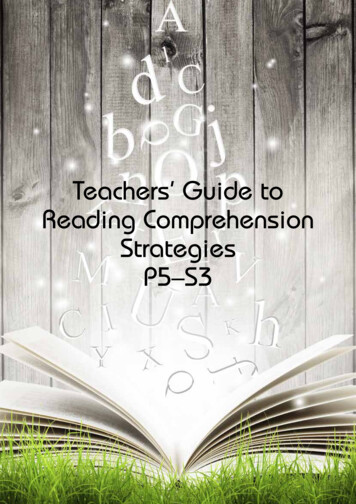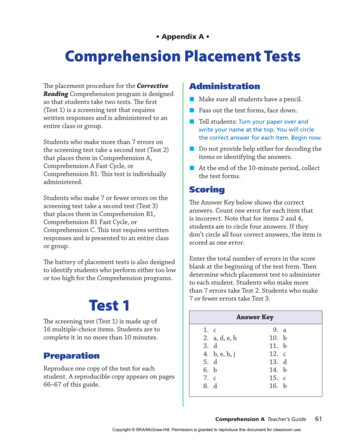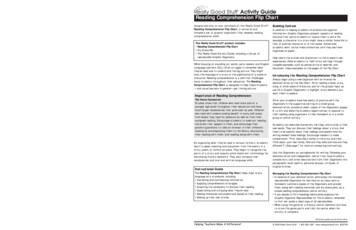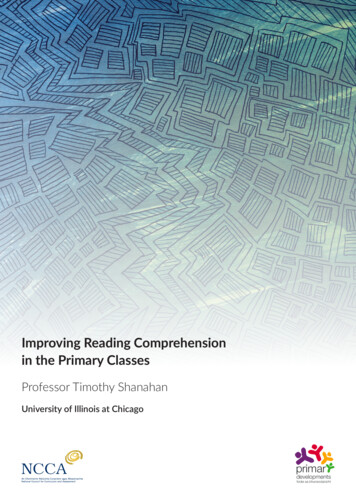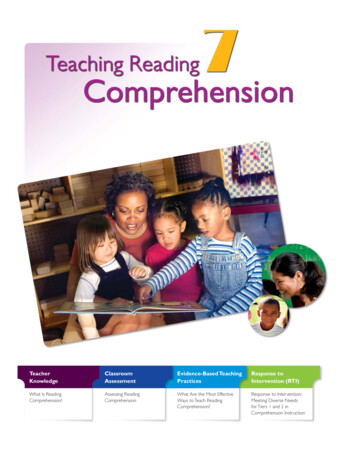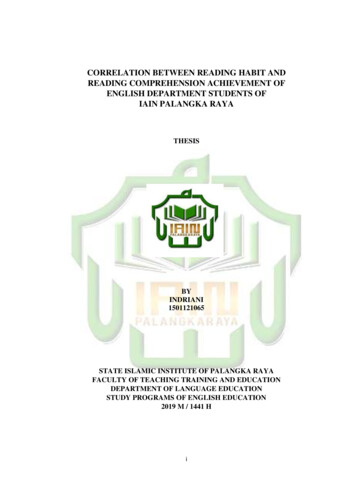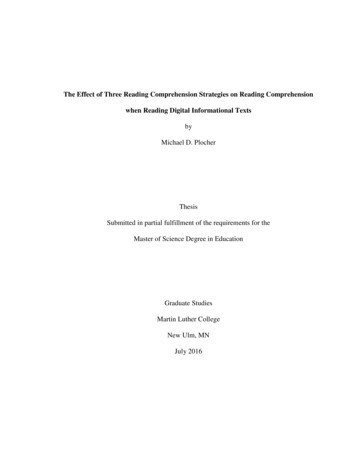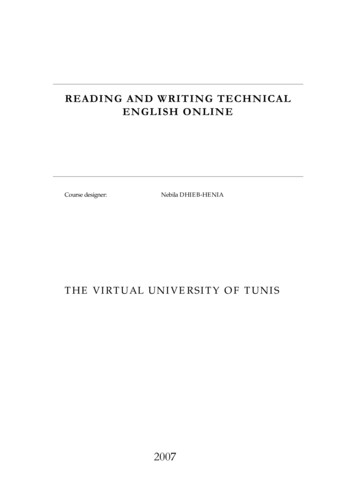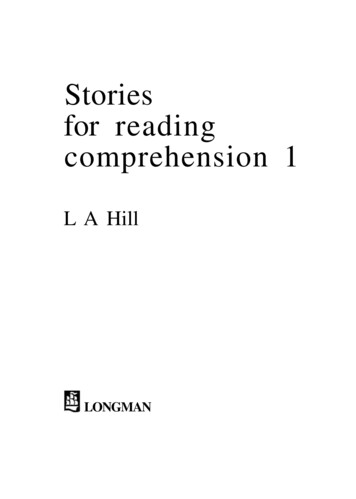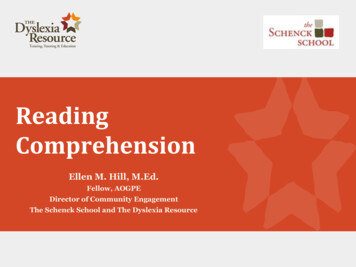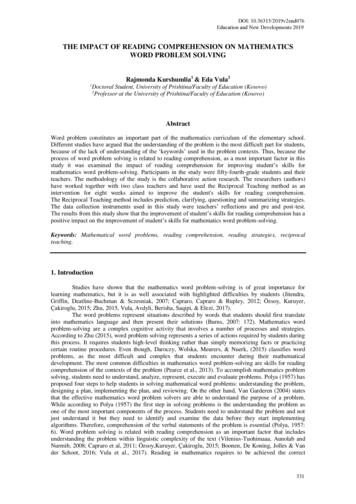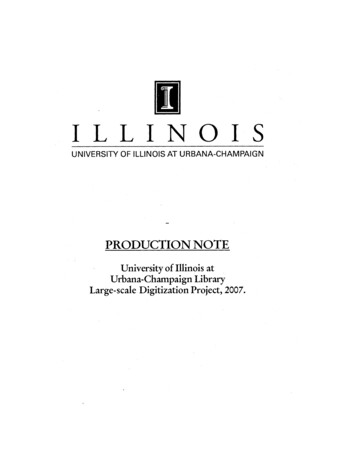
Transcription
IL I N 0SUNIVERSITY OF ILLINOIS AT URBANA-CHAMPAIGNPRODUCTION NOTEUniversity of Illinois atUrbana-Champaign LibraryLarge-scale Digitization Project, 2007.
3'/c2. /6)-'TECHNICALREP0RTSTechnicalReport No.187RESEARCH ON TEACHING READING COMPREHENSIONRobert J. TierneyUniversity of Illinois at Urbana-ChampaignJames W. CunninghamUniversity of North Carolina--ChapelHillNovember 1980Center for the Study of Reading . , Vc ,-.uAUNIVERSITY OF ILLINOISAT URBANA-CHAMPAIGN51 Gerty DriveChampaign, Illinois 61820The NationalInstitute ofEducationU.S. Department ofHealth. Education and WelfareWashington. D.C. 2020HBOLT BERANEK AND NEWMAN INC.50 Moulton StreetCambridge, Massachusetts 02138
CENTER FOR THE STUDY OF READINGTechnicalReport No.187RESEARCH ON TEACHING READING COMPREHENSIONRobert J. TierneyUniversity of Illinois at Urbana-ChampaignJames W. CunninghamUniversity of North Carolina--Chapel HillNovember 1980University of Illinoisat Urbana-Champaign51 Gerty DriveChampaign, Illinois 61820Bolt Beranek and Newman Inc.50 Moulton StreetCambridge, Massachusetts 02138To appear as a chapter in P. D. Pearson (Ed.), Handbook on ResearchReading, Longman, in press.inThe research reported herein was supported in part by the National Institute of Education under Contract No. HEW-NIE-C-400-76-0116. We wouldlike to acknowledge and thank Richard C. Anderson, Mark Aulls, Anna MarieBrophy, Jerome Harste, David Moore, David Pearson, John Readence, JosephVaughan, Jill Whaley, Cathy Wilson, and especially Jill LaZansky for theirassistance in the development of this paper.
EDITORIALPeter Johnston,BOARDChairpersonRoberta FerraraJim MosenthalScott FertigAnn MyersNicholas HastingsAndee RubinAsghar Iran-NejadWilliam TirreJillPaul WilsonLaZanskyPeter WinogradMichael Nivens,Editorial Assistant
Research on Teaching Reading ComprehensionI.II.[INTRODUCTION]. . . . . . . . . . . . . . . . . . . . . . . . .1. . . . . . . .2INCREASING LEARNING FROM TEXT/PROSE. . . . .A. . . . . . . . . .Prereading Activities1.2.The Role of Background Knowledge . . . . . . . . . . .Building Background Knowledge Prior to Reading . . . . .36e.Advance organizers . . . . . . . . . . . .Objectives . . . . . . . . . . . . . . . .Pretests and prequestions . . . . . . . .Prequestions and student-centered/generatedpurposes . . . . . . . . . . . . . . . . .Pictures, prefatory statements, and titles6810. . . . . 11. . . . . 15. . . . .1619. . . . . . . .2226. . . . . . . . . . . . . . .Guides. . .26283031Oral reading . . . . . . . . . . . . . . . . . . . . . . . . . . . . . . . . . . . .Lesson frameworksStudy guides . . . . . . . . . . . . . . . . . . .313233. . . . . . . . . . . . . . . .Frameworks,. . . .and. . . . . . .StudyTeacher Interventions Following Reading to Learn . .1.2.3. . . . . . . .Inducing Imagery . .Inserted Questions .Self-Questioning . .Oral Reading, Lessona.b.c.D. . . . . . . . . . . . . . . . . . .Guiding Reader/Text Interactions During Reading toLearn . . . . . . . . . . . . . . . . . . . . . . .1.2.3.4.C.Preteaching vocabulary . .Analogy . . . . . . . . .Activating Background Knowledge and AttentionFocusing . . . . . . . . . . . . . . . . . . . . . . . . .a.b.c.d.B. .3a.b.3. . . . . .34Postquestions . . . . . . . . . . . . . . . . . . . . . 35Feedback . . . . . . . . . . . . . . . . . . . . . . . . 37Group and Whole-Class Discussions. . . . . . . . . . .38General Comments on Increasing Learning fromText/Prose . . . . . . . . . . . . . . . . . . . . . . . .40
iiIII.INCREASING ABILITY TO LEARN FROM TEXT/PROSEA.B.[Introduction] . . . . . . . . . . . . . . . . . . . . . . .Some Directions for Research in Reading ComprehensionInstruction. . . . . . . . . . . . . . . . . . . . . . . .1.2.C.IV.General Comments on Increasing Ability to Learn FromText/Prose . . . . . . . . . . . . . . . . . . . . . . .Methodological1.2.4.5.45. .54. . . .55Issues. . . . . . . . . . . . . . . . . . .55Apply a "Greatest Likelihood Principle" to. . . . . . . . . . . . . . . . .Experimental ResearchDesign Studies Where the Complexities of Texts,Teaching and Context are Addressed and Can Reveal.Their Impact . . . . . . . . . . . . . . . . . . .a.b.c.3.42Metacomprehension and Inference Training . . . . . . . .45Meeting Text-Based Needs of Readers. . . . . . . . . .50HOW SHOULD RESEARCH IN TEACHING READING COMPREHENSIONPROCEED? . . . . . . . . . . . . . . . . . . . . . . . .A.V. . . . . . . . . .42575960Text-treatment interactions . . . . . . . . . . . .61.Teacher-treatment interactions . . . . . . . . . .Context-treatment interactions . . . . . . . . . . .63Design Studies Where the Complexities of Classroom. . . . . . . . . . . . . . .Learning Can be AddressedDesign and Implement Research Which Can be CoherentlyInterpreted in Light of the Literature from all theRelevant Disciplines . . . . . . . . . . . . . . . . . . . . . . . . . . . . . . . . . . .A Call for Action646976A FINAL WORD . . . . . . . . . . . . . . . . . . . . . . . . . .79. . . . . . . . . . . . . . . . . . . . . . . . . .80Reference NotesReferences . . . . . . . . . . . . . . . . . . . . . . . . . . . .Footnote . . . . . . . . . . . . . . . . . . . . . . . . . . Ill. .82
Teaching Reading Comprehension1Research on Teaching Reading ComprehensionThe present paper represents an attempt to address the "state of theart" relative to research on teaching reading comprehension.The readingresearcher and practitioner will find the paper a review of what we knowabout reading comprehension instruction, and a framework for addressingthe adequacy and promise of existing and forthcomingbasic questions drive our discussion:lines of inquiry.TwoWith whom, in what situations, andin what ways does teaching improve reading comprehension?How shouldresearch in teaching reading comprehension proceed?Our purpose was threefold:(a) Describe the nature and distributionof research in teaching reading comprehension in the context of stated(b) consider issues of methodologicaland/or implied instructional goals;significance as they emerge; and (c) suggest some reasonable guidelinesfor future research in accord with rising researchtive approaches to investigation.interests and alterna-We have adopted two discussion headingswhich represent the nature and scope of this research in terms oftwo fundamental goals for instruction:increasing learning from textand increasing ability to learn from text.The former reviews thelarge array of studies which examine the efficacy of teacher intervention intended to improve students'ability to understand,integrate information from specific text passages.recall,orThe latter addressesthose studies whose goal is to improve general and specific reading comprehension abilities which will transfer to students' reading of passages
Teaching Reading Comprehension2they later encounter on their own.These two discussions then merge inthe final section of the paper where we consider future directions forreading comprehensioninstructionalresearch and guidelines for how thatresearch might or should be conducted,We recognized from the outset that a review which exhausted the literature was neither realistic nor within the bounds of our goals.Instead,we decided that studies cited in the context of our remarks should beselected largely for their representativeness,significance,or promise.And, with respect to research paradigms, an attempt was made to includedescriptive studies dealing with theoreticalissues of relevance to teachingreading comprehension, empirical studies involving such prototypicalmethodology as treatment group comparisons, research syntheses of instructionalprocedures, and discussions relating aspects of pedagogicalintuition.Tothese ends, we believe the present review is comprehensive,INCREASING LEARNING FROM TEXT/PROSEIt is the purpose of this section to highlight research which studiesinstructionalrecall,intervention as a means to improve students' understanding,and integration of information,text passages.stated in or inferable from specificOur review of such interventions includes prereadingactivities, guided reading activities and postreading activities.Notethat we have drawn a distinction between activities or strategies basedupon when and for what purpose intervention takes place.might be characterized in the following trichotomy:This distinctionbuilding upon
Teaching Reading Comprehension3background knowledge, activating readers' existing background knowledgeand attention focusing before reading to learn; guiding reader-textinteractions during reading to learn; and providing review, feedback,or cognitive stimulation after reading to learn.Prereading ActivitiesMost reading lessons include a prereading activity which provides abridge of sorts between a reader's knowledge base and the text.Mostlesson frameworks used in conjunction with basals and content area textbooks consider this step a preparatory one in which purpose setting andconcept development are primary goals.In principle most of theseactivities are directed at the reader's background knowledge;implicitly,they reflect at least tacit acceptance of the role of background knowledgeand the importance of building and activating readers' knowledge beforereading to learn.The Role of Background KnowledgeIn general, both theory and research support the notion that background knowledge affects how much information is recalled and what information isrecalled from reading,as well as readers'perceptions of suchaspects of the reading situation as an author's background and purposes.Recent theorists,such as Ausubel,1963,1968,1978,and the schematheorists of the past decade (Anderson, Spiro, S Anderson, 1978; Rumelhart &Ortony, 1977; Spiro, 1977) have addressed the role of background knowledge andits relation to text comprehension, in particular as it applies to
Teaching Reading Comprehension4broader issues of processing and recalling information.of confirming this relationship,severalrecentIn the processinvestigations havecontributed toward specifying the differential impact of background knowledge upon the type and amount of informationrecalled by readers.Forexample, a study by Anderson, Reynolds, Schallert, and Goetz (1977) foundthat recall and comprehension of passages capable of two alternativeinterpretations were highly related to the background knowledge of thereaders.More physical education students took a wrestling perspectivein response to a prison/wrestling passage and a card-playing perspective inresponse to a card/music passage;for music students the reverse was true.Similarly, Steffensen, Joag-Dev, and Anderson (1979),in a cross-culturalstudy involving subjects from the United States and India, found thatsubjects tend to read more rapidly,recall more information,and producemore consistent elaborations for passages dealing with culturally relevantmaterial.A study by Pearson, Hansen, and Gordon (1979) again demonstratedthis differential effect, as the extent to which young readers were ableto respond to questions tapping implicit and explicit information tendedto vary with respect to their idiosyncratic backgrounds of experience.More recently Tierney, LaZansky, Raphael, and Mosenthal(Note 1) have ob-served familiarity to manifest itself not only in terms of what informationis recalled, but also in readers' perceptions of an author's purposes,intended audience, and relationship with that audience.In addition to providing empirical evidence for longstanding notionsregarding the role of background knowledge, such findings compel one to
Teaching Reading Comprehension5suppose that activating or building a reader's existing knowledge prior toreading to learn willimprove or at least alter comprehension and recall.As we have already suggested, if one examines the conventional wisdomof reading practices, one encounters a number of references to theimportance of activating or building background knowledge prior to reading,and an even greater barrage of specific suggestions, strategies, andactivities directed toward these ends.Yet, examining results of inter-vention studies which make use of specific strategies intended to activateor build readers'background knowledge,fragile generalization:may have, in generalvariables as texts,one isconfronted with a rathernamely, whatever positive effects these strategiestheir effects tend to vary considerably across suchteachers,and readers.Rather than suggesting thefutility of attempting to activate and build background knowledge,this situation serves to point out that:(a) we may not, at thepresent time, know enough about the relationship between intervention andlearning;(b) experimental methodology may be so distorting the instruc-tional environment that whatever effects would occur under typicalconditions are either lost or distorted;learning(c) it would be naive to assumeany strategy sensitive enough to warrant its implementation across allreading situations; and (d) current means of measuring a reader's background knowledge or assessing the impact of its activation are in needof further development.We begin our discussion of specific intervention techniques in thecontext of building background knowledge during prereading instruction.We
Teaching Reading Comprehension6hope that this discussion, and the three which follow, will provide anintroduction,some illustration,and a partial explanation of the problemsto which we have only just alluded.Building Background Knowledge Prior to ReadingWhen readers apparently lack the prior knowledge necessary to read tolearn, what can be done to compensate?in instructional literature:Three suggestions appear most oftenteach vocabulary as a prereading step; pro-vide experiences, vicarious or otherwise, which fillin and expand uponstudents' existing knowledge; or introduce a conceptualframework analogousto that of the text which will enable students to build appropriate background for themselves.Preteaching vocabulary.An enduring piece of conventional wisdom inreading education is the recommendation that students be taught crucialword meanings prior to encountering them in text.In most directed readinglessons which accompany basals and content area textbooks, introduction tonew vocabulary is an integral first step.As Bridge (in press) suggests,introduction to new vocabulary is perceived as serving "the function ofarousing previous conceptual associations and providing new associations . . to help students to relate the unfamiliar concepts to familiar ones."a similar vein, Pearson and Johnson (1978) describe such activities asproviding anchors for new information.Or as Beck, McKeown, McCaslin,and Burke (1980) have suggested, teaching vocabulary is a specializedaspect of developing background knowledge essential for comprehensionIn
Teaching Reading Comprehension7and is widespread in most reading programs.In fact, one person (Becker,1977) has recommended that disadvantaged students be taught 25 wordmeanings per week, starting in third grade and continuing through twelfthgrade, in order to compensate for the students' lack of conceptual knowledge.The fact that vocabulary development is such a widespread instructionalfocus may be partially a function of that research which alludes to the relationship between vocabulary and reading comprehension.Correlations betweenknowledge of word meanings and ability to comprehend passages containingthose words, between knowledge of word meanings and verbal intelligence, aswell as between word difficulty and passage difficulty are all high andwell established.(For a review of this work, see Anderson & Freebody,1979; Davis, 1971.)These relationships have been further demonstratedby studies which show that not only do good and poor readers appear todiffer with respect to knowledge of word meanings (Belmont & Birch, 1966),but replacing high-frequency words with low-frequency synonyms in textsdecreases subjects' passage comprehension (Marks, Doctorow, & Wittrock,1974; Wittrock,Marks,& Doctorow,1975).Less encouraging, however, are those findings related to the effectsof vocabulary instruction upon reading comprehension.Researchers employingcarefully designed interventions in which subjects are pretaught wordmeanings have consistently found that such instruction improves students'knowledge of the words taught but does not significantly improve theirpassage comprehension (Jackson & Dizney, 1963; Jenkins, Pany, & Schreck, 1978;
Teaching Reading Comprehension8Lieberman, 1967; Pany & Jenkins, 1978; Tuinman & Brady, 1974).Whilethese results may seem counterintuitive, they do suggest either that conventional wisdom is astray, or that "the effects of vocabulary knowledgeon reading comprehension are far more subtle than either conventionalwisdom or reading educators had imagined"(Jenkins & Pany,in press).Wewould posit that the subtle effects of vocabulary knowledge may have beenshort-circuited by the failure of researchers to fully consider readers'background knowledge and purposes for reading as well as such aspects oftext as key vocabulary and the relationships which exist between concepts.Thus,it may be more instructionally beneficial to ask questions similar tothe following:What types of vocabulary activities would likely build areader's background knowledge prior to reading a text?To what extentshould these vocabulary activities be individualized and extended over time?In what situations is vocabulary development likely to be essential?ways (during or after reading) willIn whatdifferences in background knowledge dueto vocabulary development most likely be manifested?Analogy.Analogy might be defined as an expositional method forcomparing sets of information which are similar enough in certain essentialrespects to permit transposition of attributes across sets,from familiar to unfamiliar information.usuallyThe classroom being what it is,explanation must often suffice for experience.Teachers, therefore, havelong operated under the assumption that while explanation via analogy isnot a substitute for experience, it affords a practical means for introducing students to unfamiliar information in the context of a familiar
Teaching Reading Comprehension9framework.Many philosophers (Black, 1962; Campbell,1920) and psychologists(Rumelhart & Ortony, 1977), especially those advocating a schema-theoreticpoint of view, concur on this point.Despite the potential utility of analogy claimed by educators,philosophers, and psychologists, research on its pedagogical efficacy hasbeen reported by only a few studies, and some of these studies only indirectly address analogy's instructional utility.Dowell(1968) and Drugge(1977) found no significant effects stemming from the instructional use ofanalogy.Mayer (1975) and Royer and Cable (1975, 1976) found results whichfavored the advance presentation of analogous material but did not directlyaddress questionsrelated to analogy's instructionalutility per se.Themost positive evidence of analogy's value comes from a study by Ausubeland Fitzgerald (1961),who found a superiority for readers given anadvance expository passage on an analogous familiar topic, and a study byHayes and Tierney (1980),who found that students given different modes ofpresenting or embedding analogous information had an advantage on certainmeasures over students not given analogies.Generally, the results suggestthat if analogy is to be used effectively to increase background knowledge,care must be taken in:(a) the selection of students, as one would expectthe benefits of analogy to manifest themselves differently for readers ofvarying abilities and backgrounds of experience;(b)the presentation of theanalogous information, as it is likely different modes will have differentimpacts; and (c) the methods used to assess effects.In terms of our thirdpoint, we would posit that any research attempting to improve background knowledge
Teaching Reading Comprehension10needs to consider the possibility that a complex interaction exists amongteaching methodology, texts, topics, and readers, and needs to recognizethat the influence of changes in background knowledge may be subtle and difficultto measure except with a variety of on-line as well as posttest measureswhich are sensitive to the idiosyncratic nature of the analogy to be studied.Activating Background Knowledge and Attention-FocusingIf readers have the necessary background knowledge prior to readingto learn, what can or should be done to activate that knowledge or focusattention in order to expedite their learning from text?Many theoristsand practitioners advocate strategies which encourage students to activelyrelate the new information they gain from reading to their prior knowledge.Such strategies are based on the assumption that learning is a constructiveprocess rather than merely one of acquisition.A number of suggestionsfor activating background knowledge have arisen as a result, a great manydirected at teachers, a very few directed at students, and still fewerdirected at texts.For the purposes of discussion, we have selected thefollowing as illustrative of teacher initiated/directed strategies foractivating background knowledge:pretests and prequesticns.advance organizers, objectives, andFrom among those strategies indicative ofstudent generated/monitored activity, we willgenerated questions and purposes.consider student centered/With respect to text adjuncts we willdiscuss prefatory statements, pictures, and titles.
Teaching Reading ComprehensionIIAdvance organizers.One of the most widely researched and contro-versial strategies designed to activate a reader's background knowledgeis that of the advance organizer, proposed by Ausubel(1963, 1968).In Ausubel's (1968) words, the intent of the advance organizer is "tobridge the gap between what the reader already knows and what the readerneeds to know before he/she can meaningfully learn the task at hand"(p. 148).Based upon Ausubel's theory of verbal learning, which posits theexistence of hierarchically organized cognitive structures, the functionof the organizer is to provide ideational scaffolding for the stable incorporation and retention of the more detailed and differentiated materialthat follows in the passage.In a practical sense, its purpose is toprepare readers to gain information from reading they could not have other-wise gained (Bransford, 1979).Ausubel(1978) has suggested that for advance organizers to functioneffectively they must be written at a higher level of abstraction orgenerality than the material to be learned, address the conditions oftheir specific use, account for both the reader's existing subsumers andthe unfamiliar concepts presented within the text, and take into accountthose factors involved in posttesting.In the case of unfamiliar material,Ausubel prescribes the use of an expository organizer to provide "relevantproximate subsumers."With familiar material, he suggests a comparativeorganizer to facilitate the integration of new ideas and to increase discrimination between ideas.
Teaching Reading Comprehension12There is some evidence that advance organizers effect the subsequentlearning of some students some of the time with some texts when readershave some prerequisite knowledge (Ausubel, 1978; Bransford, 1979).How-ever, despite the fact that several hundred research studies and anynumber of synthesis attempts have explored the differential worth ofadvance organizers, we still lack any "real"instructional value.closure regarding theirOver the years researchers intent on synthesizingthe bulk of advance organizer research have resorted to extensive literaturereviews(Barnes & Clawson,1975; Hartley & Davies,1976; Lawton & Wanska,1977; Mayer, 1979) and, most recently, meta-analysis, a statisticaltechnique suggested by Glass (1978) to standardize and compare treatmenteffects (Luiten, Ames, & Ackerson, Note 2; Moore & Readence, 1980).such review of the research by Sledge (1978),Onewhich focused on the useof advance organizers with secondary students, reported that the majorityof studies did not favor advance organizers and,in studies for whichdifferences did favor advance organizers, less capable students benefitedmost.A more recent synthesis, a meta-analysis which examined trendsacross 135 advance organizer studiesthe following:(Luiten,et al.,Note 2), suggestedmost advance organizer treatment groups tended to performbetter than control groups; the effect of advance organizers had avariable impact across special education, elementary, secondary, andcollege students; the impact of aural and visual organizers varied withthe age level of students; and the effect of advance organizers tended toincrease rather than decay over time.
Teaching Reading Comprehension13Two major problems have had the effect of diminishing the worth ofmost individual advance organizer research studies and synthesis attempts.The first,manifestin the lack of a clearly specified operationaldefinition of advance organizers, has left advance organizer researchlargely nonreplicable.Theoretical position papers, research reviews, andresearch reports have virtually failed to provide either teachers orresearchers with specific guidelines for developing advance organizers.Unfortunately, Ausubel(1978) suggests that "apart from describingorganizers in general terms with an appropriate example, one cannot bemore specific about the construction of an organizer.For this alwaysdepends on the nature of the learning material, the age of the learner,and his degree of prior familiarity with the learning passage" (p. 251).These "generalterms" to which Ausubelrefers are scattered through-out his writings and in what appears to us to be poorly articulatedexamples.The result is such that for any single text, a variety ofadvance organizers might be generated and the differential effect ofany one might become a legitimate research question.The second problem relates to the global nature of those questionsresearchers tend to ask about advance organizers.warning with respect to the differentialGiven Ausubel'snature of learning materialand varying needs of learners, it seems misguided for researchers andpractitioners to continue to explore the efficacy of the advance organizerwithout regard for the different potential effects these variablesmay have.Questions should be pursued that go beyond the general
Teaching Reading Comprehension14issue of whether or not advance organizers work.Clearly, only in thecontext of examining a variety of data across a variety of specifictexts can researchers hope to develop descriptions which address theinstructional and theoretical significance of the advance organizer ina useful manner.In content reading classes, for example, social studies and science,there exists a hybrid of the advance organizer--the structured overview-whose widely advocated use deserves some comment.In theoretical papers,both Barron (1969) and Earle (196 9a) proposed the development and useof a visual overview to introduce students to the concepts and relationships represented within a text or a unit within a course.They pro-posed that the overview incorporate the terms arranged in outlineform to effectively highlight to students the content of a text or unit,including its logical structure.In so doing, it was believed that theoverview assumed the properties of Ausubel's advance organizer; that is, itrelated "new content to relevant subsuming concepts that have previouslybeen learned" (Barron, 1969, p. 33).Unfortunately, to date the researchdealing with the effectiveness of these graphic overviews suffers fromone of the same major problems ailing advance organizer research--namely,the probes which have driven the research have failed to systematicallyexamine the impact of the strategy beyond whether or not it works.Studiesconducted in various content classrooms have provided general support thatunder certain conditions with certain students structured overviews havea positive effect on learning; however, these investigations have provided
Teaching Reading Comprehension15very littledata of an explanatory nature.The types of students,textsand reading situations for which different types of overviews might beeffective has not been clarified 7; Barron,& Barron,1971; Berget,1969; Vacca,1977;1977; Walker,1979).Those who endorse the use of behavioral objectives fre-quently argue that as teacher-directed prereading activities, behavioralobjectives facilitate students'organization of their learning; this argu-ment is based to some extent upon the assumption that ifwhat they are expected to learn,more systematically.they willR. Gagn6 (1965),students knowtend to pursue their learningfor example,rationalizes the use ofbehavioral objectives by proposing that objectives aid students in organizingtheir learning, through the clarification of individual goals which permitnot only more efficient study time but also a system for monitoring individual progress.While common sense would suggest that providing students with objectives before they read to learn will enhance that learning (Levin &Pressley,in press),Duchastel and Merrillsuch a facilitative effect is far from certain.(1973)reviewed the effects of providing behavioralobjectives on student achievement and found that few studies show apositive effect.Further,in a review of over forty research studieswhich were analyzed in terms of teaching strategies,and learner characteristics,". .behavioralHartley and Davies(1976)task characteristics,concluded thatobjectives have an effect upon learning,but this [effect]is less clear cut than many of the advocates of behavioral objectives
Teaching Reading Comprehension16usually claim" (p. 251).Hartley and Davies suggest that the facilita-tive effect of behavioral objectives depends upon the cognitive tasks,student ability, and text organization.T
Teaching Reading Comprehension 1 Research on Teaching Reading Comprehension The present paper represents an attempt to address the "state of the art" relative to research on teaching reading comprehension. The reading researcher and
